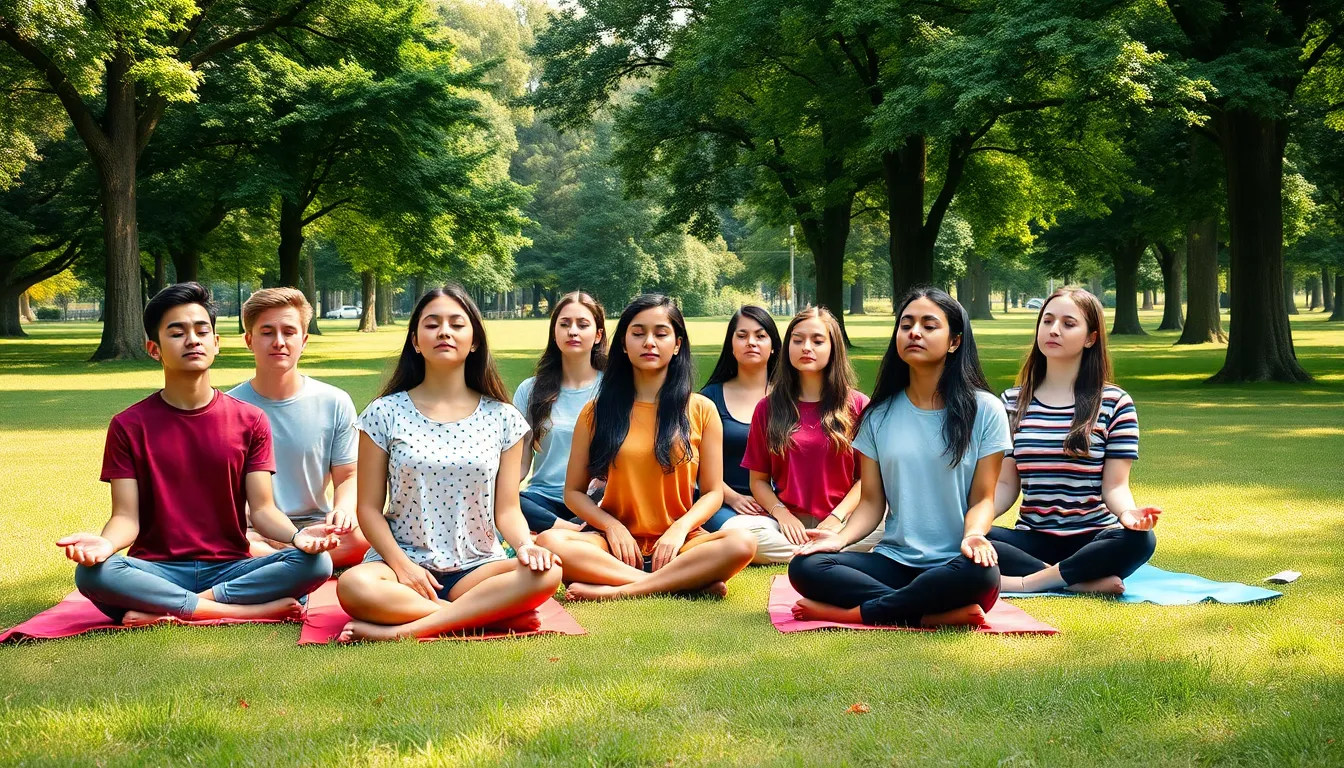In a world buzzing with social media notifications and endless homework, teens often find themselves juggling stress like a circus performer. But what if they could swap that chaos for calm? Mindfulness exercises offer a refreshing escape, helping young minds navigate their emotions and focus better.
mindfulness exercises for teens
Mindfulness exercises provide effective methods for teens to manage stress and improve overall well-being. Practicing mindfulness can enhance self-awareness, helping them become more attuned to their thoughts and feelings. Engaging in these exercises often leads to improved emotional regulation and increased focus in academic and social settings.
Common mindfulness exercises include breathing techniques, body scans, and mindful observations. Breathing techniques encourage teens to concentrate on their breath, fostering a sense of calm during stressful moments. Body scans involve focusing on different areas of the body, promoting relaxation and awareness of physical sensations. Mindful observations challenge teens to fully engage with their surroundings, enhancing their appreciation for everyday experiences.
Incorporating mindfulness into daily routines can yield significant benefits. Setting aside just a few minutes for mindfulness exercises each day can help prevent overwhelming feelings. Participating in group mindfulness sessions can create a supportive environment where teens share experiences and learn from one another.
Numerous studies indicate that consistent mindfulness practice positively impacts mental health outcomes for adolescents. Reductions in anxiety, depression, and stress levels correspond with regular engagement in mindfulness exercises. This evidence reinforces the importance of making mindfulness a priority in the lives of young people.
Accessibility of mindfulness resources also supports its adoption among teens. Mobile apps and online platforms provide guided exercises that are easy to follow. Schools increasingly integrate mindfulness programs into curricula, promoting mental wellness among students.
By committing to mindfulness exercises, teens cultivate resilience and coping strategies that serve them throughout their lives.
Benefits Of Mindfulness For Teenagers

Mindfulness practices offer significant advantages for teenagers navigating stress and emotional challenges. These benefits encompass improved mental health and enhanced focus.
Improved Mental Health
Mindfulness exercises contribute to better mental health outcomes for teens. Research shows that consistent mindfulness practice reduces anxiety, depression, and overall stress levels. This reduction arises from the promotion of emotional regulation and a greater understanding of one’s feelings. Teens who engage in mindfulness often report feeling more balanced and content. They also find it easier to cope with daily pressures. Additionally, communities and schools that facilitate mindfulness activities create supportive environments, further enhancing these positive effects.
Enhanced Focus And Concentration
Mindfulness exercises significantly improve teens’ ability to concentrate and maintain focus. The practice encourages awareness of thoughts and distractions, leading to better attention control. A focused mind fosters improved academic performance and enhances participation in activities. Teens who incorporate mindfulness techniques often find it easier to stay engaged during classes and homework sessions. This newfound ability to concentrate contributes to a more fulfilling learning experience. Moreover, regular practice helps build mental clarity, enabling teens to approach tasks with intention and purpose.
Popular Mindfulness Exercises For Teens
Mindfulness exercises help teens navigate stress and enhance their emotional well-being. Below are some popular practices that cultivate awareness and focus.
Breathing Techniques
Breathing techniques promote relaxation and mental clarity. Teens can try the 4-7-8 method, inhaling for four seconds, holding for seven, and exhaling for eight. Practicing this routine for a few minutes daily allows for a calmer mindset. Another option includes box breathing, where individuals inhale, hold, exhale, and hold again for equal counts. This technique encourages focus and helps relieve anxiety. Regular practice can establish a grounding effect, making it easier for teens to handle challenging emotions.
Guided Meditations
Guided meditations provide structured mindfulness experiences. Many apps offer tailored sessions lasting from five to twenty minutes, making meditation more accessible. Young people can listen to calming voices leading them through visualizations or breathing exercises. Research indicates that these meditations significantly lower stress levels and improve emotional regulation. Incorporating guided meditation into a daily routine can spark awareness and foster deeper connections with oneself. Furthermore, these sessions often encourage reflections on personal experiences, enhancing self-understanding.
Journaling Practices
Journaling practices give teens a creative outlet for their thoughts and feelings. Reflective writing offers space for emotional expression and enhances self-awareness. Setting aside time each day for journaling helps to process events and emotions. Prompts such as “What am I grateful for today?” or “What challenged me this week?” guide reflections. This practice cultivates mindfulness and allows teens to track their growth over time. Regular journaling can also improve problem-solving skills and promote clearer thinking.
Tips For Incorporating Mindfulness Into Daily Life
Integrating mindfulness into daily routines enhances emotional regulation and well-being. Simple strategies enable teens to practice mindfulness consistently.
Setting A Routine
Establishing a daily mindfulness routine aids in reinforcing habits. Morning practices can include five minutes of breathing techniques or meditation. Incorporating mindfulness into after-school activities creates a calming transition from academic stress. Evening reflections, like journaling about daily experiences, foster self-awareness and promote relaxation before sleep. Consistency is key; allocating specific times for mindfulness throughout the day creates a structured environment conducive to emotional balance.
Creating A Mindful Space
Designing a dedicated mindful space at home promotes focus and relaxation. Use calming colors and minimal distractions to cultivate serenity. Place comfortable seating or cushions in a quiet area for practice, enhancing comfort and engagement. Adding elements, such as plants or soothing sounds, encourages connection and tranquility. Personalizing the space with meaningful items, like quotes or photos, can further inspire mindfulness. This intentional environment aids in establishing a positive and enriching mindfulness practice.
Conclusion
Mindfulness exercises offer teens a powerful way to manage stress and enhance their overall well-being. By incorporating practices like breathing techniques and journaling into their daily routines, they can cultivate resilience and emotional balance. Establishing a mindful space at home and dedicating time for these exercises can further support their journey toward improved mental health.
As teens navigate the complexities of adolescence, embracing mindfulness can lead to lasting benefits. With consistent practice, they can develop a deeper understanding of themselves and better cope with life’s challenges. Ultimately, mindfulness empowers young people to approach each day with clarity and purpose, fostering a healthier, more balanced lifestyle.



